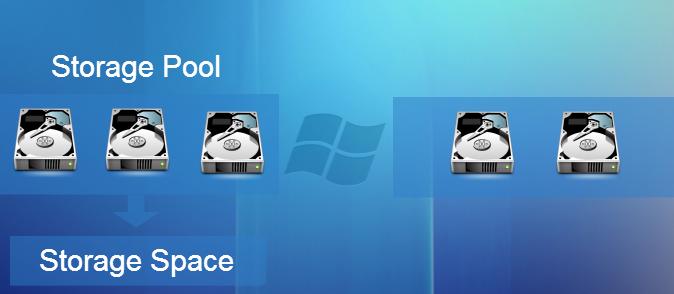
- Summary
- Storage Pool
- Storage Space
Summary
Since the availability of Windows Server 2012, several new features of storage have made their appearance. This is the case with Storage Pools and Storage Space which offer new possibilities for storing and organizing data.
Both of these features allow you to virtualize storage, firstly because the Storage Pool is the grouping of a set of physical disks, on the other hand, because the Storage Space is a virtual volume created in a Storage Pool.
Now, it’s time to look more closely at these two concepts to better understand it…
Storage Pool
A storage pool is a group (aggregate) of virtual physical disks; these disks can be of different types: standard hard drives (SATA), SSDs…
Consider a server where 5 hard drives are inserted. Generally, you would run these disks by the Windows Disk Manager (which is limited), or you would have probably acquired a RAID card for your server and managed data redundancy by a RAID array, regardless of the layer system.
With a storage pool, we will create a virtual cluster of these disks without necessarily having to select them all in the same storage pool because you can create multiple. Moreover, with Windows Server 2012 R2, a storage pool can contain up to 240 physical disks, and the data volume meanwhile would be up to 480.
Here is a representation of a storage pool:

In business, we can find a “JBOD” filled SAS disk and then connected to a server, or even multiple servers. This configuration has not been required since a NAS (single storage server) with multiple drives can play the same role.
It should be noted that the management of storage pools occurs by Server Manager or PowerShell which is handy for certain operations.
Finally, know that it’s possible to add additional drives to an existing storage pool.

Storage Space
A storage Space is a virtual disk created in a seamless storage pool. This is in the storage space selected for the type of redundancy that is desired as in the case of a RAID, such as mirroring and parity.
The advantage of storage virtualization is that it’s not necessary to have the RAID controller hardware. Windows incorporates a dedicated controller for it and manages it all at the layer system. For information, this controller is called a “Windows Controller Storage Space” and therefore does not have a RAID controller on the server.
Of course, a storage pool can consist of several storage spaces within the limit of the available space on the storage pool.
To go deeper into the details of the data redundancy, here are the modes available:
– Simple: No redundancy, disk space is used to optimally optimize performance (equivalent to RAID 0 – Stripping)
– Mirror: Duplication of data on disk 2 or 3 discs, depending on the mode and the number of available disks. The triple mirror allows for tolerating the loss of two disks.
– Parity: Distribution of data and parity bits across the disks in the storage pool, like RAID 5, 3 discs at least are necessary to allow the loss of a disk…
When creating a storage space, disk space allocated on the storage pool can be provisioned in two different ways:
– Dynamic (thin): Space is allocated progressively until it reaches the limit set by the user. In other words, allocates only what is used.
– Fixed: Space is allocated and fully booked from the start even if everything is not used.